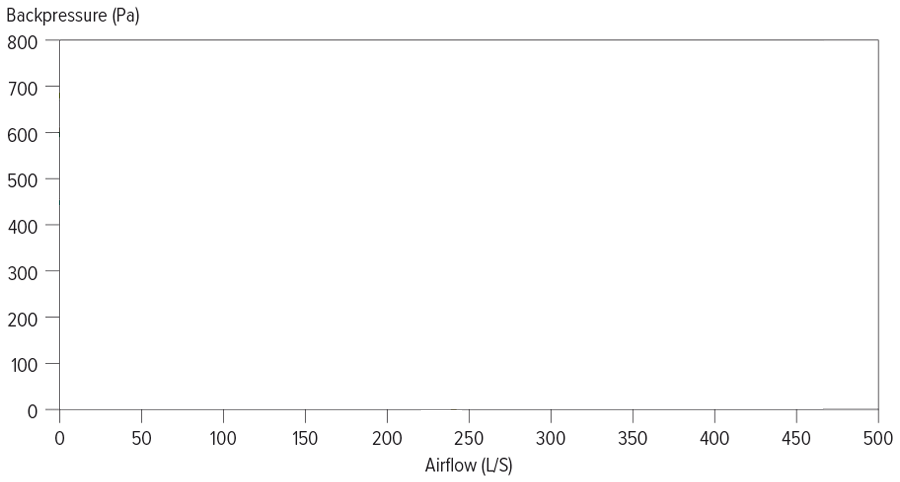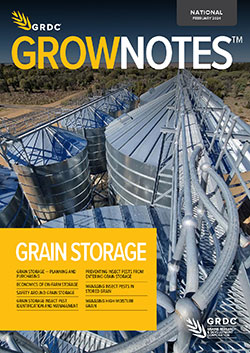Key points
- Grain type significantly affects aeration system performance
- Ensure aeration systems are designed for the grains being stored
- Ask manufacturers whether specified airflow rates are calculated or field-tested
Keeping grain cool in storage is critical in minimising insect activity and life cycle speed, as well as maintaining grain quality, but new research shows it is not a one-size-fits-all approach.
On-farm grain storage is providing new opportunities for growers to maximise price and improve harvest logistics, GRDC grower relations manager – north – Graeme Sandral says. “The big change in recent times is the expansion of fan-forced, sealable silos, but you need to be aware of fan performance to maximise benefits.”
Research – recently presented by Alex Conway from the GRDC Grain Storage Extension team – shows that aeration performance varies significantly depending on the type of grain being stored. The amount of grain in the silo and how it settles also has an impact on airflow.
Mr Conway, as an agricultural engineer, says the insights will help to ensure that growers can safely reap the benefits that storing grain on-farm provides, such as flexibility with harvest and marketing.
“To leverage these benefits, we need to make sure that aeration systems are designed appropriately to keep grain cool to maintain quality and germination potential, and minimise insects,” he says.
Ideally, in an Australian summer, grain should be stored between 18˚C and 23˚C, dropping to 15˚C degrees or less in winter, with the lower temperature often stopping the insect life cycle.
Mr Conway says the research shines new light on the role of ‘back pressure’ – the resistance to airflow through the grain itself – which, until now, was largely based on Northern Hemisphere research from the 1950s. “We found the original dataset was a great resource, but becoming quite outdated and we should update that information for industry using Australian grain types and varieties.”
Under pressure
Using high-precision measuring equipment and a test rig built specifically for the research, along with extensive in-field testing, the extension team has built a new understanding of how aeration backpressure changes with different grain types, depths and the way grain settles. They found backpressure varies “dramatically” according to grain type.
To cool grain, airflow rates of between two and four litres per second for each tonne of grain in storage is required. But higher backpressure leads to less airflow, which can reduce the effectiveness of aeration cooling for particular grains.
In canola, for example, the testing found that backpressure could be 2.4 times greater than wheat. As wheat is the standard to which conventional aeration systems are designed, airflow would be less effective with canola than with wheat on standard settings, Mr Conway says.
The research also showed there was greater backpressure and therefore potential for lower-performing aeration in grains such sorghum and lentils. Meanwhile, soybeans, barley, chickpeas, oats and maize produced less backpressure than wheat.
Figure 1: The performance of four aeration fans varied significantly according to fan design, despite having the same 0.37kW motor.
 Source: Alex Conway
Source: Alex Conway
GRDC Grain Storage Extension national coordinator Chris Warrick says smaller grain size appears to induce greater backpressure on the aeration system than larger grains, which do not stack as tightly. He says it is assumed that larger grain size creates more air gaps, allowing for easier airflow through the grain.
“So the real key takeaway for industry is that we need to make sure we’re aware of what grains we’re storing and how it’s going to affect our aeration system,” Mr Conway says.
“If existing silos are likely to be designed for wheat, we need to understand that, if we’re trying to push the boundaries on moisture for sorghum or something similar at harvest, our airflow might not be quite as good.”
The effectiveness of aeration systems could also be influenced by the way different types of grains settle in the silo. Tests comparing the impact on aeration backpressure of loosely filled grain compared with settled-down, tight grain showed very little difference for grains such as field pea or maize. But for lentils and sorghum, even just a small increase in bulk density (10 per cent) led to a 60 per cent increase in backpressure. This impacts the aeration system’s ability to cool grain.
The research also validated the assumption that airflow takes the path of least resistance. This means that in a typically filled silo, with a peak of grain at the centre, airflow is higher in volume at the silo walls. If some grain is removed, leaving a concave-shaped surface, the scenario is reversed and more air flows through the centre.
Fit for purpose
Mr Warrick says these findings show that growers should ensure that updated aeration systems are designed to meet their needs – particularly around what types of grain will be most commonly stored.

It is also critical that growers ask manufacturers targeted questions about fan output, Mr Conway says. This is because the team’s fan performance testing (with the cooperation of manufacturers) showed airflow function varied significantly between different brands under the same level of backpressure, despite having the same-sized electric motor. “So it’s really important to be aware that the same-sized fans do not necessarily produce the same airflow output.”
Testing also found that some fans were producing as little as 50 per cent of the airflow that the manufacturers were quoting. “So it’s really important to question specified airflow rates with manufacturers,” he says.
“Make sure that they are field testing their fans and the performance of their aeration systems and it’s not just based on calculated values.”
More information: For a range of handy resources on Australian grains research see the stored grain website or the GRDC GrowNotes™ ‘Grain Storage’. Both are available as a hard copy through GRDC or downloadable as a PDF from the stored grain or GRDC websites. To speak to a member of the GRDC Grain Storage Extension team call the 1800 WEEVIL hotline.
For the latest research results on backpressure aeration, see page 58 in GrowNotes™ 'Grain Storage'.

























































